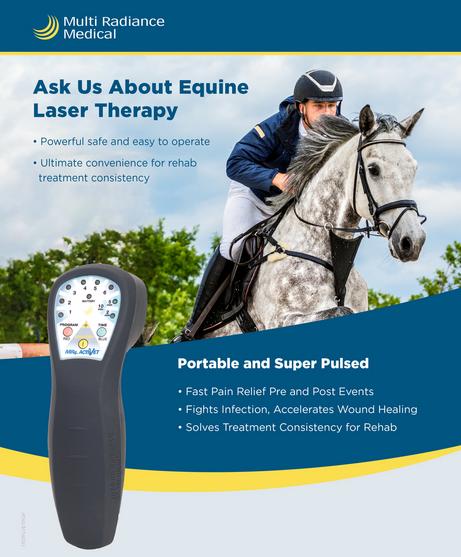Equine Therapy for Injury Healing: How Steeds Assist Heal Emotional Wounds
Equine Therapy for Injury Healing: How Steeds Assist Heal Emotional Wounds
Blog Article
Laser Therapy in Equine Therapy: A Modern Method to Improving Equine Wellness
Laser treatment has actually emerged as a pivotal technique in equine therapy, using concentrated light energy to promote cellular repair and speed up recuperation from a variety of ailments. This non-invasive approach is particularly efficient in managing bone and joint injuries, wounds, and inflammatory conditions, dramatically boosting general equine health. By promoting mitochondrial task and boosting ATP production, laser treatment not only boosts flow but likewise gives considerable pain alleviation. As this ingenious therapy remains to gain traction, it opens intriguing opportunities for addressing chronic problems like arthritis and hoof troubles, signifying a transformative shift in vet treatment. What makes this modality specifically compelling?
Understanding Laser Therapy
Laser treatment, a non-invasive treatment modality, has actually acquired considerable grip in equine medicine due to its efficacy in advertising recovery and pain alleviation. Improved ATP degrees accelerate tissue repair work processes and minimize inflammation, making laser therapy especially reliable for dealing with bone and joint injuries, injuries, and other inflammatory problems in equines.
There are several types of lasers utilized in equine therapy, each with certain wavelengths and power outputs tailored to various restorative demands. Low-level laser therapy (LLLT), also referred to as cold laser treatment, employs lower power levels to boost cell function without triggering thermal damage. High-intensity laser treatment (HILT), on the other hand, makes use of greater power degrees to accomplish much deeper tissue infiltration and more considerable therapeutic impacts.
Veterinarians make use of various laser gadgets and techniques depending upon the problem being treated and the wanted depth of cells penetration. Appropriate training and experience are vital for guaranteeing the secure and effective application of laser therapy, consequently optimizing its restorative possibility while lessening dangers.
Benefits for Horse Wellness
With a solid understanding of how laser therapy works, it is very important to explore its various benefits for equine health. One of the primary benefits is its ability to increase cells fixing and cell development. By stimulating mobile feature, laser treatment promotes faster wound healing and help in the regrowth of broken tissues. This can be especially valuable in reducing recuperation times for steeds enduring from injuries.
Additionally, laser therapy has been revealed to improve circulation, thereby boosting blood circulation to affected locations. Improved circulation makes certain that crucial nutrients and oxygen are provided much more efficiently, promoting the recovery process. In addition, laser therapy's anti-inflammatory effects assist in decreasing swelling and pain, which is important for the general health of the equine.
Pain administration is another substantial benefit. By launching endorphins and blocking discomfort signals, laser treatment provides efficient, non-invasive relief from both severe and Bonuses chronic discomfort. This can add to enhanced mobility and top quality of life for the animal.
Finally, laser treatment is a non-invasive treatment alternative, lessening the risk of issues related to even more invasive procedures. Its versatility and effectiveness make it an important device in modern equine vet medication.
Typical Problems Treated

An additional widespread problem treated with laser therapy is arthritis. Additionally, laser treatment is used in the monitoring of injuries.
Equine respiratory system conditions, such as recurrent respiratory tract blockage (RAO), also respond positively to laser therapy. Laser treatment is helpful in treating unguis problems, including laminitis and abscesses.
Treatment and Security
Implementing laser therapy in equine therapy involves a careful procedure to make sure both effectiveness and safety and security. Equine Therapy. The process begins with a comprehensive vet assessment to figure out the viability of laser therapy for the equine's specific condition. When deemed proper, the therapy area is prepared by cleaning and, if needed, clipping the hair to boost laser penetration
The specialist has to select the appropriate kind of laser, commonly a low-level laser (LLLT) or a high-power laser (HPL), depending upon the condition being treated. The laser tool is then he said calibrated to the proper wavelength, power, and period setups. Throughout the application, the specialist moves the laser over the targeted location in an organized fashion, guaranteeing constant and also direct exposure.
Safety and Visit Your URL security methods are purely followed, consisting of using protective eyewear for both the professional and the steed. In addition, it is crucial to keep track of the equine for any type of indications of pain or negative responses throughout the procedure. Post-treatment, the equine is typically provided a period of rest to enable the restorative impacts to materialize.

Future of Horse Laser Treatment
As innovations in vet medication remain to unfold, the future of equine laser therapy holds substantial assurance. Arising innovations and deeper clinical understandings are set to refine and expand the applications of laser treatment for equines. One of one of the most expected advancements is the integration of innovative imaging methods that permit more accurate targeting of affected tissues, thereby boosting restorative outcomes. In addition, the advancement of mobile and straightforward laser gadgets is most likely to make this therapy a lot more easily accessible to a broader series of specialists and steed owners.
Additionally, ongoing research study right into the molecular and cellular systems of laser treatment will likely yield enhanced protocols tailored to certain problems, enhancing performance and reducing treatment times. Individualized treatment plans based on genetic and biochemical pens could come true, guaranteeing that each equine receives one of the most appropriate and effective treatment.
In addition, governing advancements and standardization of protocols will certainly boost the integrity and integrity of laser therapy in equine method. Equine Therapy. As these advancements proceed to emerge, equine laser therapy is poised to end up being a crucial component of veterinary care, offering enhanced healing and enhanced high quality of life for steeds around the world
Conclusion

Report this page